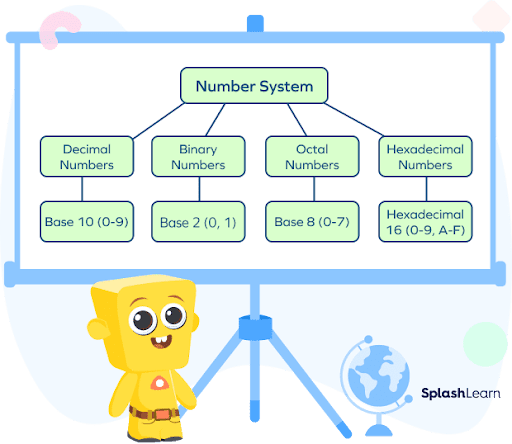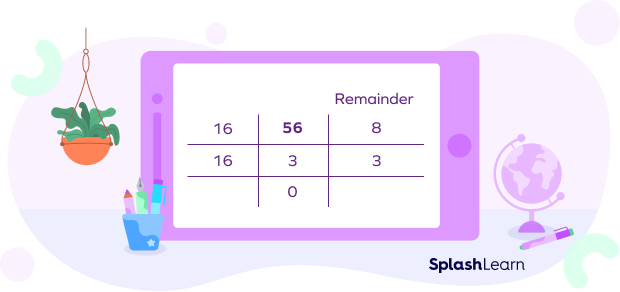What Is the Octal Number System?
The octal number system is a number system with base 8. A number system is a system of representing numbers. The number system is a way to represent numbers using a collection of symbols and guidelines. The most commonly used number system is the decimal number system, which has base 10 and uses ten digits 0 to 9 to form other numbers.
Here’s a chart showing different number systems and the number of digits used in each system.

The octal numeral system is the base-8 number system, and uses the digits 0 to 7. That means there are only 8 symbols or digits (0, 1, 2, 3, 4, 5, 6, 7) used to form other numbers.
The main advantage of using the octal number system is that it uses fewer digits than the decimal and hexadecimal number system. So, it has fewer calculations and thereby less calculation errors.
Definition of Octal Number System
A number system with base 8 is called an octal number system. The position of every digit has a value which is a power of 8. A number in the octal number system is represented with the number 8 at the base, like $512_8,\; 56_8$, etc.
Now let us understand how the interconversions between these systems are done.
Recommended Games
Conversion of Octal to Binary Numbers
The base of the octal number system is 8. The base of the binary number system is 2. To convert octal to binary, we need to convert each number from the octal number to the binary number. Take a look at the octal to binary conversion table given below:
| Octal Value | Binary Equivalent |
| 0 | 000 |
| 1 | 001 |
| 2 | 010 |
| 3 | 011 |
| 4 | 100 |
| 5 | 101 |
| 6 | 110 |
| 7 | 111 |
Every digit has to be converted to a 3-bit binary number. Thus, we get the binary equivalent of the number. Let’s understand this with the help of an example.
Example: Convert $(16)_8$ into a binary number.
Solution: $(16)_8$ is an octal number.
With the help of the above conversion table, we can write
$1_8 = 001_2$ and $6_8 = 110_2$
Thus, $(16)_8 = (001110)_2$
Recommended Worksheets
Conversion of Octal to Decimal Numbers
Converting octal to decimal is a simple process!
A number in the octal system is expanded with the base of eight, where each digit is multiplied with the power of 8, based on its position.
After the octal is converted to decimal, it has a base of 10.
Let us understand this with the help of an example:
Example: Convert $(321)_8$ to decimal form.
Solution:
$(321)_8 = (3\times8^2) + (2\times8^1) + (1\times8^0)$
$= (3\times64) + (2\times8) + (1\times1)$
$= 192 + 16 + 1$
$= 209_{10}$
Thus, $(321)_8 = (209)_{10}$
| Octalbase 8 | Decimalbase 10 |
| 0 | 0 |
| 1 | 1 |
| 2 | 2 |
| 3 | 3 |
| 4 | 4 |
| 5 | 5 |
| 6 | 6 |
| 7 | 7 |
| 10 | 8 |
| 11 | 9 |
| 12 | 10 |
| 13 | 11 |
| 14 | 12 |
| 15 | 13 |
| 16 | 14 |
Conversion of Decimal to Octal Number
In this conversion, the decimal number is divided by 8 each time a reminder is obtained from the previous digit. Let us understand this conversion with the help of an example.
Example: Convert $416_{10}$ to octal.
Divide 416 by the octal base number, 8.
| Division by 8 | Quotient | Remainder |
|---|---|---|
| $416\div8$ | 52 | 0 |
| $52\div8$ | 6 | 4 |
| $6\div8$ | 0 | 6 |
We stop when the quotient value becomes 0. By writing the remainders in reverse order, we get the equivalent octal number. Thus, the octal representation of 416 is 640.
Hence, $(416)_{10} = (640)_8$
Conversion of Octal to Hexadecimal Numbers
The hexadecimal number system has a base of 16 and uses sixteen symbols. It uses numbers from 0 to 9 and alphabets A to F.
| Octal | Hexadecimal |
| 0 | 0 |
| 1 | 1 |
| 2 | 2 |
| 3 | 3 |
| 4 | 4 |
| 5 | 5 |
| 6 | 6 |
| 7 | 7 |
| 10 | 8 |
| 11 | 9 |
| 12 | A |
| 13 | B |
| 14 | C |
| 15 | D |
| 16 | E |
| 17 | F |
| 20 | 10 |
Alt tag: Octal to hexadecimal conversion table
The simplest way is to first convert the octal number to a decimal, and then the decimal to a hexadecimal number.
Let us understand octal to hexadecimal conversion with the help of an example.
Example: Convert $(70)_8$ to hexadecimal.
Step 1: Octal to Decimal
$(70)_8 = (7\times8^1) + (0\times8^0)$
$(70)_8 = (56)_{10}$
Step 2: Decimal to hexadecimal
Now, we need to convert $(56)_{10}$ to a hexadecimal number.
Divide the number 56 by 16 until the number in the quotient value becomes 0.

Write remainders in reverse order.
Therefore, $(70)_8 = (38)_{16}$
Octal Multiplication Table
You can multiply octal numbers in two ways. One way is to convert octal to decimal: perform the decimal multiplication to get the product and convert the result back to octal. The second way is simply using the octal multiplication table.
Example:
| $\times$ | 0 | 1 | 2 | 3 | 4 | 5 | 6 | 7 |
| 0 | 0 | 0 | 0 | 0 | 0 | 0 | 0 | 0 |
| 1 | 0 | 1 | 2 | 3 | 4 | 5 | 6 | 7 |
| 2 | 0 | 2 | 4 | 6 | 10 | 12 | 14 | 16 |
| 3 | 0 | 3 | 6 | 11 | 14 | 17 | 22 | 25 |
| 4 | 0 | 4 | 10 | 14 | 20 | 24 | 30 | 34 |
| 5 | 0 | 5 | 12 | 17 | 24 | 31 | 36 | 43 |
| 6 | 0 | 6 | 14 | 22 | 30 | 36 | 44 | 52 |
| 7 | 0 | 7 | 16 | 25 | 34 | 43 | 52 | 61 |
Alt tag: Octal multiplication table
Facts about the Octal Number System
- In 1801, James Anderson criticized the French for basing the metric system on decimal arithmetic. He suggested the base 8 and he coined the term octal.
- The main advantage of using octal numbers is that it uses fewer digits than the decimal and hexadecimal number system. So, it has fewer computations and less computational errors.
- The octal number system is widely used in computer application sectors and digital numbering systems. The octal number is also used in the aviation sector in the form of a code.
- The octal system is similar to the hexadecimal system because they are both easily converted to binary, where octal is equal to three-digit binary and hexadecimal is equal to four-digit binary.
Conclusion
In this article, we have learned about the octal number system and the interconversions between octal, binary, hexadecimal, and decimal. Let us solve some examples based on the concepts we have covered.
Solved Examples on Octal Number System
Example 1: Convert $(242)_8$ into a binary number
Solution:
$(242)_8$is an octal number.
With the help of the octal to binary conversion table, we have:
$2_8 = 010_2$ and $4_8 = 100_2$
$(242)_8 = (010100010)_2$
Hence, $(242)_8 = (010100010)_2$
Example 2: Convert decimal number 33 to the octal number.
Solution:
Divide 33 by 8 and note down the remainder at each step.

Thus, $33_10 = 41_8$
Example 3: Convert octal number $(560)_8$ to decimal form.
Solution:
To convert octal to decimal, we need to multiply each digit of the octal number by the corresponding power of eight.
$(560)_8 = (5\times8^2) + (6\times8^1) + (0\times8^0)$
$= (5\times64) + (6\times8) + (0\times1)$
$= 320 + 48 + 0$
$= 368$
Thus, $(560)_8 = (368)_{10}$
Example 4: Convert $725_{10}$ to octal.
Solution:
Divide the given number 725 by 8.
| Division by 8 | Quotient | Remainder |
|---|---|---|
| $725\div8$ | 90 | 5 |
| $90\div8$ | 11 | 2 |
| $11\div8$ | 1 | 3 |
| $1\div8$ | 0 | 1 |
Writing the remainders in reverse order, we get the equivalent octal number. Thus, the octal representation of 725 is 1325.
Hence, $(725)_{10} = (1325)_8$
Example 5: Convert the octal number $(452)_8$ to a hexadecimal number.
Solution:
Here we need to first convert the octal number to a decimal number and then convert it to a hexadecimal number.
$(452)_8 = 4\times8^2 + 5\times8^1 + 2\times8^0$
$= 4\times64 + 5\times8 + 2\times1$
$= 256 + 40 + 2$
$(452)_8 = (298)_{10}$
Hence, the decimal number is $(298)_{10}$.
Now we can find out the hexadecimal number by dividing 298 by 16 until the remainder is less than 16.
$\frac{298}{16} = 18$, remainder $= 10$
$\frac{18}{16} = 1$, remainder $= 2$
$\frac{1}{16} = 0$, remainder $= 1$
Using decimal to hexadecimal conversion table, we have $10 = A$
Write the remainders in reverse order.
$(452)_8 = (12A)_{16}$
Thus, $(452)_8 = (12A)_{16}$
Practice Problems on Octal Number System
Octal Number System - Definition, Conversions, Examples, FAQs
A number system with its base as _________ is known as the octal number system.
The octal numeral system, or oct for short has base 8.
The octal system uses the numbers from _________ .
The octal numeral system, or oct for short, is the base 8 number system, and uses the digits 0 to 7.
What is the decimal equivalent of $100_8$?
$100_8 = (1\times8^2) + (0\times8^1) + (0\times8^0) = 64_{10}$
Frequently Asked Questions on Octal Number System
What is the use of the octal number system ?
The octal number system provides a convenient way of converting large binary numbers into more compact and smaller groups. However, the octal number system is less popular. Since the base value of the octal number system is 8, their maximum value of digit is 7 and it can not be more than 7.
How do we convert binary to octal?
Group all the 1s and 0s in the binary number in sets of three, starting from the far right. Add zeros to the left of the last digit if you don’t have enough digits to make a set of three. Compare your sets of binary numbers to this octal conversion chart.
Let us understand this conversion with the help of an example:
Convert $(11100100)_2$ into an octal number.
$(011100100)_2 = 011 | 100 | 100 = 344$
Therefore, $(11100100)_2 = (344)_8$
What are the disadvantages of the octal number system?
The major disadvantage of the octal number system is that the computer doesn’t understand the octal number system. So the additional circuit is required for the digital systems, which convert the octal number to binary number. The octal number system is used in minicomputers.
How can we add octal numbers?
There are different ways for adding octal numbers. One way is converting the numbers to be added into decimal numbers, and finding the sum as a decimal number. Finally, convert the result back to an octal number. Another way is using an octal addition table. It gives instant result & requires no calculation,
What comes after the number 7 in octal counting?
The octal number after 7 is 10. The decimal number 8 is represented as 10 in the octal number system. There is no 8 or 9 in the octal number system.




































